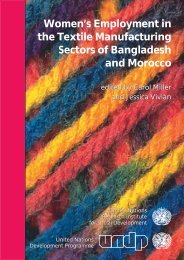Environmental Degradation and Social Integration - United Nations ...
Environmental Degradation and Social Integration - United Nations ...
Environmental Degradation and Social Integration - United Nations ...
You also want an ePaper? Increase the reach of your titles
YUMPU automatically turns print PDFs into web optimized ePapers that Google loves.
undertake productive activities other than overexploiting natural resources. Remittances also enable<br />
the migrants’ families to meet livelihood needs by purchasing necessities. Again, social institutions<br />
must evolve rapidly in areas of out-migration. The desertion of rural communities whose<br />
inhabitants were previously managing their resources sustainably may accelerate environmental<br />
degradation because traditions of natural resource management <strong>and</strong> knowledge of local ecosystems<br />
are lost.<br />
These considerations suggest that the role of permanent <strong>and</strong> temporary migration merits special<br />
attention in any discussion of environmental dynamics. Under what circumstances is migration an<br />
important grassroots response to hardships induced by resource scarcity, deforestation or other<br />
types of environmental decline? What are its effects on the livelihoods of the migrants <strong>and</strong> of those<br />
who remain in their home communities? What are its impacts on processes of environmental<br />
degradation? What are the social consequences for earlier residents in areas receiving the migrants?<br />
A set of case studies on the social dynamics of deforestation suggests that the answers to these<br />
questions are extremely varied <strong>and</strong> often contradictory in different contexts. The researchers<br />
encountered three principal reasons for migratory movements affecting deforestation processes.<br />
First, there were forced migrations because of war, political persecution or eviction following l<strong>and</strong><br />
alienation or loss of employment. Residents evicted to make way for reservoirs <strong>and</strong> other largescale<br />
development projects were found in all the regions studied. Second, there were so-called<br />
ecological refugees, who left their homes to seek other l<strong>and</strong>s or incomes when their forests <strong>and</strong><br />
soils become too degraded for them to maintain their customary livelihoods. Third, many left<br />
temporarily or permanently merely to improve their opportunities <strong>and</strong> incomes, or to lessen their<br />
own <strong>and</strong> their families’ poverty. In practice, it is often impossible to distinguish clearly between socalled<br />
“push” <strong>and</strong> “pull” factors as they usually operate simultaneously.<br />
Collective Action<br />
Collective actions of those being prejudiced by environmental degradation processes can<br />
sometimes enable such groups to increase their control over resources <strong>and</strong> regulatory institutions,<br />
although they can also be very risky for those undertaking them. Perhaps the most important aspect<br />
of organized collective efforts by the weak to protect their resources, or merely to improve their<br />
livelihoods, is that such organization sometimes compels the powerful to take them seriously as<br />
social actors in their own right. Without autonomous grassroots organization by the people most<br />
affected, it is easy for representatives of the state, the timber industry, large l<strong>and</strong>owners <strong>and</strong> others<br />
seeking to exploit their resources to see such people as mere objects of “development”. When<br />
collectively organized with some degree of autonomy, however, they are more likely to be seen as<br />
potential allies or opponents whose interests must be taken into account. In many circumstances,<br />
collective organization provides the weak with greater bargaining power, although in others it may<br />
prompt harsh reprisals (see box 5).<br />
Effective collective action by local communities to protect their resources from seizure by more<br />
powerful groups is always difficult—<strong>and</strong> can be extremely dangerous. Some individuals <strong>and</strong><br />
households will inevitably have divergent interests from others. The greater the social stratification<br />
in a community, <strong>and</strong> especially market-induced stratification, the more likely it is that contradictory<br />
interests will arise, <strong>and</strong> be fomented by outsiders wanting access to community l<strong>and</strong>s.<br />
Collective initiatives are further constrained by the fact that there is often not only a clash of<br />
interests, but also a clash of cultures between different groups interested in utilizing natural<br />
resources. Cultural differences are in turn associated with different modes of production <strong>and</strong><br />
resource use. Hunters <strong>and</strong> gatherers have competed for l<strong>and</strong> <strong>and</strong> forest resources with nomadic
















